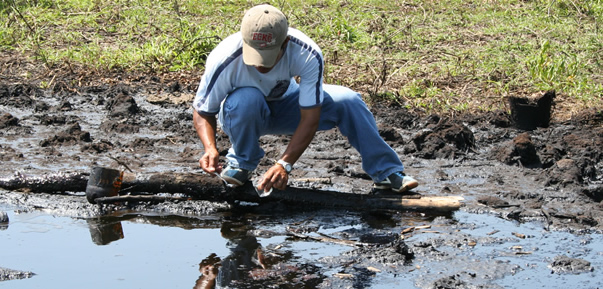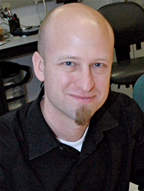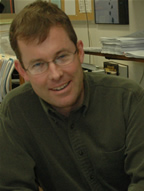Tracking Ancient Olmec Through Tar
Tar Seeps May Be Key to Unlocking Olmec Mysteries
February 20, 2007
By Russ Hudson
Research
being conducted now by two Cal State Fullerton faculty members could
shed a great deal of light on the ancient Olmec civilization.
The Olmec,
who were dominant in southern Mexico from about 1200 to 500 B.C., are considered
by many experts to be the “parent civilization” to the Maya and
Aztec because of artistic and cultural themes that trace back beyond those
two peoples. The Olmec, however, are largely a mystery.
It wasn’t
even until well into the 20th century that it was determined the Olmec were
a separate, and older, civilization than the other two. Now there are studies
trying to determine what manner of people they were. Did they keep to themselves?
Did they trade widely? Did they conquer their neighbors? The latter is currently
a hotly debated topic among those studying Mesomerica, the area from central
Mexico to about mid-Central America.
So how are Carl
Wendt, assistant professor of anthropology, and Scott
Hewitt, professor of chemistry, tracing the movements of the Olmec, and,
through their movements, learning more about their civilization?
They’re
using asphalt … tar. Or more scientifically, bitumen.
It is the
same tar-like substance that is found at La Brea Tar Pits near downtown Los
Angeles. Bitumen was formed when layer after layer of plankton and underwater
vegetation sank to the bottom of the sea, was gradually covered by thousands
of feet and billions of tons of other sediment, decayed and was “cooked” by
the Earth’s heat to the black, gooey substance that seeps up through
the Earth’s crust to form pools on the surface.
Clues to a Civilization
“The
Olmec used the bitumen to seal canoes and boats, for weatherproofing and as
an adhesive,” Wendt said. “We believe they traded bitumen. It was
a valuable commodity and could be used for trade. And, of course, it traveled
with them as part of their watercraft and so forth.
“Many
seeps have a distinctive chemical makeup because of the organics that went
into them. They act as markers — sort of like the bitumen seep’s
DNA — to the point that you can track the asphalt used in ancient pots
and dwelling sites to a particular seep,” Wendt continued. “That
tells us how far it traveled after it was gathered, and that can, in turn,
indicate whether there was a great deal of trade and interaction within the
Olmec lands and outside of it.”
Whether
or not the Olmec engaged in territorial acquisition — that is, conquest — is
currently an intensely debated topic among experts. Depending on what information
is turned up in Wendt and Hewitt’s research, it could end up shedding
light on that hot topic.
A $66,867
National Science Foundation grant, the first payment of a planned total of
$115,037 over two years, will fund high-tech searching for the seeps, as well
as even better ways to analyze the asphalt found at archaeological sites.
“With
this funding, we’re going to try to use satellite imaging to find the
seeps,” said Wendt. “We’ll want images of the area in infrared
and other bandwidths, and we’ll look for other signatures. ”
Field Work
Wendt has
found many seeps already, using much lower-tech methods. Dressed in long pants — “There
are snakes, ticks and chiggers out there. No shorts for me,” the experienced
Wendt said — boots, a serviceable shirt and always a hat to ward off
the tropical sun, the anthropologist does what he calls “ground consultation.”
That is, “we
go to areas of interest and ask the people we see,” said Wendt. “We
found we have to bring photographs and videos of seeps and vials of bitumen
so they can see it. We’ll ask if they know of a place where there is
a seep of this stuff and we might get a ‘No,’ until some older
person will come out of the back of the house, look at the vial and say, ‘Yes,
there is a pool of that only a few miles from here.”
That revelation
can lead to a drive over dirt roads, boats up a river and through swampy areas,
or even a long trek overland.
“But
what was really useful, oddly enough, were the records from 1872, when there
were people down here scouting a route for what would eventually become the
Panama Canal,” noted Wendt. “They recorded the locations of many ‘tar
seeps,’ thinking they could exploit them for use in construction of the
canal. We also were able to access some of the records from the Mexican petroleum
company Pemex after I met with them. It also didn’t hurt that some of
the towns or areas were named ‘Chapo’ or ‘Chapopote,’ which
means asphalt. That was a pretty good indicator.”
Once the
seep samples have been taken and catalogued, samples from pottery and other
artifacts from the Olmec period that have asphalt adhering to them are also
collected and all are delivered to Hewitt. Another phase of the research begins.
“First
of all, those seeps are still used constantly, so those who find the artifacts
have to be sure they are ancient,” said Hewitt. “People there still
use it for much the same purposes as the Olmec did when they were dominant.
For example, “on
one trip down to that area it was found that a woman had gathered asphalt from
a local seep and completely coated her patio with it so it would have a smooth
finish,” Hewitt explained.
“The
asphalt hardens, then over time it oxidizes, which is a key factor. It’s
just as when you see a freshly covered road and it is smooth and black. Then,
awhile later, it is gray. That is oxidation. The artifact asphalt we find has
oxidized for anywhere from several hundred to 3,000 years. We need accurate
assessments of the chemical makeup in spite of that in order to match it with
a particular seep.”
Students Gain Insight
Right now,
Hewitt and the students working with him — biochemistry majors Ebby Safari
and Mike Saade are using gas chromatography to date the samples. If it proves
not to be sensitive enough, they will switch to liquid chromatography. “UC
Riverside has liquid chromatography. Maybe we can go there to do the work,” Hewitt
said. “If it works, we might well write a grant to get that equipment
funded here.”
“You
know,” Hewitt added, “the idea is to be able to track the movements
of the Olmec in order to help determine what kind of people they were. Bitumen
is one way to do that, but anything that helps is good. Carl has been studying
the Olmec and the people in what was the Olmec area for a long time.”
In fact,
Wendt’s master’s and doctoral theses were on the area and its ancient
people, and he has published repeatedly on the subject.
“I’m
selecting and organizing graduate students now. Have been for the last few
months,” Wendt said. “We’ll leave in late May for that area
and be gone all summer. We’ll be checking everything. We’ll be
looking in museums, talking to museum directors, and talking to archaeologists.
And we’ll be finding seeps.”



